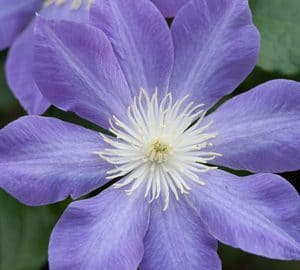
Clematis Care
How to Grow Clematis
Clematis vines are a fantastic group of plants offering bold seasonal colours. From the beautiful, large-flowered hybrids to the more subtle but equally stunning smaller-flowered species, these plants have definitely earned their place in the spotlight.
How to Plant Clematis
Clematis are typically sold in either plastic or fibre pots. If your plant comes in a plastic pot, be sure to remove it completely before planting. If it comes in a fibre pot, leave the pot in place — just trim the rim down to soil level and make three vertical cuts halfway up from the bottom to allow roots to grow through. Fibre pots will naturally break down over time in the soil.
Start by digging a hole four to five inches deeper than the root ball. This allows you to create a base of enriched soil beneath the plant for better root growth. Place the clematis in the hole so that the top of the root ball is just slightly above ground level, then backfill with your enriched soil mix. Gently press the soil down and water thoroughly.
Tip: Clematis like cool roots and warm tops, so consider mulching around the base or planting low-growing perennials nearby to shade the soil.
How to Care for Clematis
Caring for a clematis is easy—if you know a few simple tricks! With the right support and attention, these vigorous climbers will reward you with stunning blooms year after year.
- Sunlight: Most clematis varieties prefer at least 6 hours of sun per day. Some can tolerate part shade, but flowering is usually better with more sun.
- Watering: Clematis like consistent moisture, especially during their first growing season. Water deeply once or twice a week, more often during hot or dry periods.
- Mulching: Keep the roots cool and moist by adding a 2–3 inch layer of mulch around the base of the plant. Avoid piling mulch directly against the stem.
- Fertilizing: Feed your clematis with a balanced fertilizer in early spring, and again after the first flush of blooms to encourage reblooming in some varieties.
- Support: Clematis are natural climbers and need something to grow on, such as a trellis, arbor, or fence. Gently tie young vines to their support if needed until they start to twine on their own.
- Pruning: Pruning needs vary by clematis type. Some bloom on old wood, others on new. Check your variety and prune accordingly to avoid cutting off future flowers.
With a little care and the right setup, your clematis will become a standout feature in your garden—year after year.
Soil Conditions
Clematis prefers fertile, well-drained soil. Alkaline soils can be attained by regular applications of horticultural lime around the root ball. Regular watering is required to ensure the root ball does not dry out.
Fertilizing
Clematis should be fertilized regularly to maintain healthy growth and flowering potential. Also, a regular application of organic fertilizer will help to maintain good soil structure.
Light Requirements
Clematis prefers a sunny location but will not tolerate excessively hot environments. Some varieties will adapt to lower light conditions, such as north- or east-facing exposures, and still bloom quite well. Equally important is that the roots of a clematis plant stay cool. Provide shade from nearby leafy shrubs or perennials. The use of mulch also helps to reduce soil temperatures.
Pruning
Perhaps the most challenging aspect of clematis care is their pruning requirements. Different varieties flower at different times of the year, and in order to prune properly, one needs to know its blooming habits. Generally, clematis can be organized in one of the following groups:
- Group 1
Blooms in early spring on last year’s growth. Prune only dead or weak branches after flowering to tidy the plant. - Group 2
Blooms on new growth in May, June or July. Light pruning to strong buds in April is recommended to promote branching. - Group 3
Blooms late in the season, from July through the fall. They can be pruned back hard in early April to just above a good set of buds, usually around 30 cm.
Clematis tips
Clematis vines need to be supported with a trellis or archway. They can also be trained to ramble over stumps and rocks or to grow among the shrubbery. Taller growing varieties should be selected for archway and arbour applications.
Planting two to three different varieties of clematis will provide a sequence of bloom, contributing a continuous display of colour to the garden.
